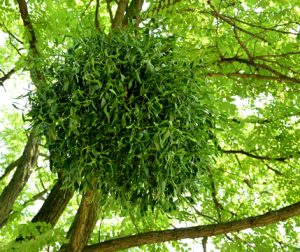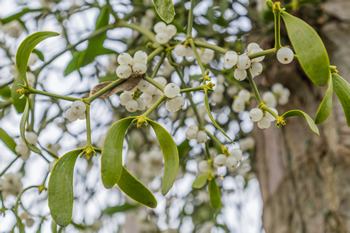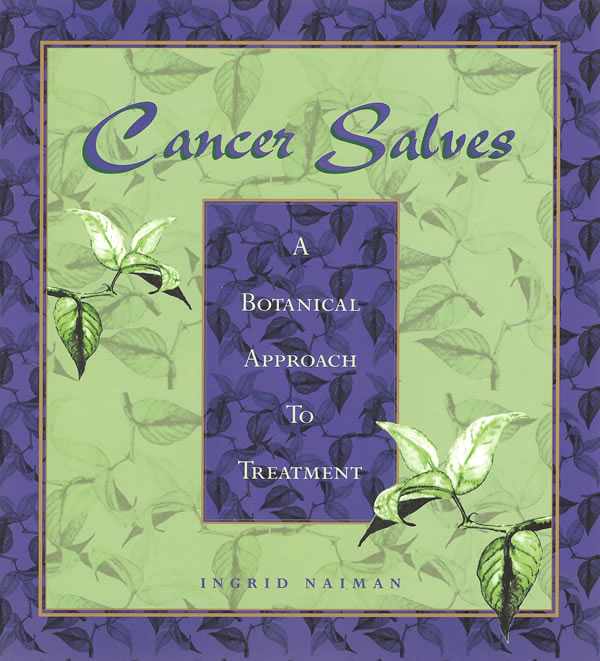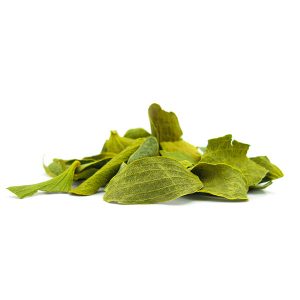Iscador
When Suzanne Somers announced on Larry King Live that she was using Iscador in her breast cancer treatment, there was a surge of interest in mistletoe.
Botanical Name: Viscum album
English: Mistletoe
Native Habitat: Mistletoe grows on trees from the British Isles to Japan and Scandinavia to North Africa.
Plant Description
Iscador is a derivative of Viscum album, a mistletoe plant that grows in many parts of the world. It was developed as a cancer therapy by Anthroposophical researchers who were driven by a hint from Rudolf Steiner (1861-1925) that mistletoe could be rendered effective in the treatment of cancer.
 Mistletoe is a parasitic plant. It does not grow in the soil (not the species referred to by Steiner) but rather in the bark of trees. It grows perpendicular to the branch in which it thrusts its sucker, and it does not obey many of the laws of the plant kingdom. For instance, its berries ripen in winter, without warmth. It stores up chlorophyll and is green all year long and is indifferent to light. It is thus neither geotropic nor phototropic and this is the fact that fascinated Anthroposophical researchers Kaelin and Leroi. Iscador is the result of many years of painstaking effort to examine the medical potential of mistletoe.
Mistletoe is a parasitic plant. It does not grow in the soil (not the species referred to by Steiner) but rather in the bark of trees. It grows perpendicular to the branch in which it thrusts its sucker, and it does not obey many of the laws of the plant kingdom. For instance, its berries ripen in winter, without warmth. It stores up chlorophyll and is green all year long and is indifferent to light. It is thus neither geotropic nor phototropic and this is the fact that fascinated Anthroposophical researchers Kaelin and Leroi. Iscador is the result of many years of painstaking effort to examine the medical potential of mistletoe.
Rudolf Steiner and Mistletoe
Steiner was a mystic and founder of Anthroposophy, considered by some to be an offshoot of Theosophy. Anthroposophy came into being during the war years when communications with the German-language world were disrupted. Steiner was not, however, entirely derivative. He was, in many respects original.
The researchers who developed Iscador took their hints from the vision that Steiner had that mistletoe could be emancipated from both Cosmic and terrestrial forces. How so?
While Steiner felt that mistletoe could replace the scalpel, Anthroposophical doctors are quick to admit that Iscador is not there yet. They use Iscador in conjunction with conventional therapies, such as irradiation, to protect against injury. Iscador itself comes in many varieties. It is made by fermentation, not the usual powder or alcoholic extracts.
The Doctrine of Similars
Steiner’s statements did not make it easy for those who wished to make practical use of his understanding. He suggested making a preparation of winter and summer Viscum album, a parasitic plant that grows on trees and may have some
Mistletoe does not grow on healthy trees. When it does grow on trees, removing the mistletoe results in the death of the tree. This is truly fascinating. The mistletoe may actually be performing a service to the tree, but what would happen to the mistletoe if the tree is healed?
Facts of the Somers' Story
Suzanne Somers was diagnosed with breast cancer in April 2001. A routine mammogram had failed to reveal a 2.4 cm
In her announcement, Somers referred to the 1000-page book by Burton Goldberg. Here are some relevant excerpts from the material on Iscador:
Iscador is “made from fermented extracts of European mistletoe, some forms of which are combined with small amounts of metals to produce certain desired, anticancer effects.”
Further down, there is a quotation from Dr. Richard Wagner of Stuttgatt who says, “it is immediately apparent that patients given mistletoe treatment have better survival quality (than those on chemotherapy), with the survival period presumably the same. We would therefore always prefer mistletoe treatment in this particular situation.”
Somers seems to believe that Iscador is a homeopathic remedy and has published material on her choices on her website. Her confusion may be due to the fact that the doctor providing the treatment is a well-known homeopath; however, Iscador — in the form developed in Europe—is not a
Office of Technology Assessments
In a 1990 report, the OTA published the following:
Mistletoe has long been used in the treatment of a variety of acute and chronic conditions. It was not widely used for treating cancer, however, until the 1920s, during the early development of Anthroposophy, a modern ‘spiritual science’ applied to medicine and a variety of other disciplines. At present, mistletoe is given to patients either as the central component of a complex, broader treatment regimen in the practice of Anthroposophic medicine mainly in Europe or as a single agent partially or completely removed from the overall context of Anthroposophic care (e.g., in the United Kingdom and other countries). At present, mistletoe preparations are advocated mainly by Swiss and German physicians
Iscador Treatment
Iscador is used extensively in a well-known clinic in Switzerland, the Lukas
Cancer can be many things – disease, destiny, opportunity, life drama or tragedy, a biographical turning point. But it is always a biological process and part of life.
It goes on to discuss the biological processes in a mixture of scientific, philosophical, and poetic speculations. According to them, cells come into being through a process of division, and they have a certain life expectancy based on the genetic potential. The death of cells, apoptosis, is assumed to be subject to the vagaries of fate and genes. Cells have a life cycle, birth to death, and before death, they pass information to the new cell, basically explaining to the new cells its functions as well as what it should look like, how it should divide, and when it will die.
There is really nothing new about this theory except the assumptions about how information is transferred. We all know that cells divide and that when they do, they may be absolutely normal or deformed. Some abnormal cells die and others replicate. Basically, cancer is a disease characterized by excessive reproduction of abnormal cells. The theories that affect why a cell mutates during the course of division are numerous: alcohol, tobacco, infection, pH imbalances, radiation, toxicity, nutrient deficiencies, message errors, and, of course, the catchall: stress. One theory is that the more deviant the cell is, the faster it reproduces; however, in the case of healthy individuals, these cells have a lower survival potential: they die and are consumed by white blood cells.
Development of Medicine from Mistletoe
With the thoroughness of German scientific inquiry, a botanist named Karl von Tubeuf began in 1907 to collect all that was known about mistletoe, this from science, mythology, and cultural traditions. He published a monograph in 1923. Both von Tubeuf and Steiner were fascinated by the anomalies of the plant.
 Mistletoe has little white berries that are quite toxic to humans, but birds enjoy them. The birds either eat only the pulp and leave a sticky seed in the tree or they eat the whole berry, seed and all, and deposit the sticky payload when they eliminate the undigested seed when they pass
Mistletoe has little white berries that are quite toxic to humans, but birds enjoy them. The birds either eat only the pulp and leave a sticky seed in the tree or they eat the whole berry, seed and all, and deposit the sticky payload when they eliminate the undigested seed when they pass
The growth process of the ball-like mistletoe plant is slow. It flowers after 5-7 years but is only harvested for use in medicines after 10-15 years. The first “Anthroposophical mistletoe medicines” were made by a
National Cancer Institute on Mistletoe
- Mistletoe is a parasitic plant that has been used since ancient times to treat a variety of human ailments.
- Extracts of mistletoe have been shown to kill cancer cells in the laboratory and to stimulate the immune system.
- Three components of mistletoe (lectins, alkaloids, and viscotoxins) may be responsible for its biologic effects.
- Mixed results have been obtained in animals studies that have investigated the ability of mistletoe extracts to slow
tumor growth. - There is no evidence from well-designed clinical trials that mistletoe or any of its components are effective treatments for human cancer.
- Mistletoe plants and berries are toxic to humans, and mistletoe extracts are not sold commercially in the United States.
Author's Remarks
Steiner used complex metaphysics to express his understanding, in general as well as specifically when applied to mistletoe. He felt that science and spirituality could work together to create medicines of the future. Where cancer is concerned, he felt that there are various organizing forces that result in degrees of chaos or order. His theories are basically nearly impossible to address with the tools of modern medicine. It is therefore necessary to look at results rather than mechanisms for action.
Iscador is not seen by those who use it as a cure for cancer. It is a treatment that most often is used in conjunction with other conventional treatments, especially radiation but also surgery. It is given both before and after these procedures so as to promote rapid recovery and reduce adverse reactions, such as metastasis. Different studies seem to suggest different assessments of the treatment. When used instead of chemotherapy, the quality of life is significantly better for patients being treated with Iscador than for patients undergoing chemotherapy. For those who are treating localized
Treatment with Iscador is generally not claimed to result in
Having devoted more than three decades to medical philosophy and alternative treatments, it is with some reticence and yet support that I wish to note that many of the serious investigations of unusual protocols have been carried out in Germany where: (1) holistic medicine is not a stepchild but rather an optional pursuit in normal medical schools, and (2) mysticism and medicine have found an alliance, not only in Anthroposophical medicine but Hildegard medicine and Father Kneipp’s therapies. I said “reticence” not because of any personal hesitation but rather awareness that science invariably wishes to prove matters on its own terms.
Copyright by Ingrid Naiman 2003
See also: Guest Post on Mistletoe

This study of mistletoe for cancer treatment gathers together the work and research of doctors using Iscador. It aims to answer many of the questions about Iscador, offer an overview of the terms, procedures, and different approaches to cancer treatment, and suggests different dietary options.
$19.75
Image Credits
Dry Mistletoe Leaves
Dreamstime ID 10662581
© Uros Petrovic
Mistletoe Hanging from Tree
Dreamstime ID 55694117
© Renata Routova
Mistletoe Berries
Dreamstime ID 55694117
© Hilda
Many experts throughout history have regarded cancer salves and pastes as the most thorough, safe, and efficacious way to treat cancer, especially skin and breast cancers but also cancers of other organs. In this book, Ingrid Naiman meticulously traces the use of such products in ancient India and by Hildegard of Bingen, Native Americans, and modern physicians. She provides detailed instructions for making and using the salves, a fair comparison of the pros and cons, and eight pages of color pictures showing responses to the products. Visit her Cancer Salves site for more information, answers to frequently asked questions, and a checklist for people facing cancer.

Cancer Plants
Donations
Your donations are greatly appreciated.
Information
Newsletter
To be notified of new posts to this site, please subscribe, using the link button below. You can cancel your subscription at any time you choose.
Copyright by Dr. Ingrid Naiman 2003 and 2018
All Rights Reserved || Institute for Invisible Epidemics

